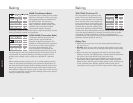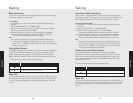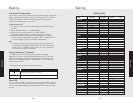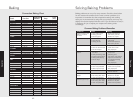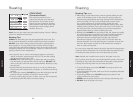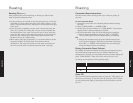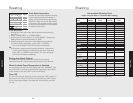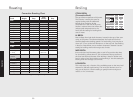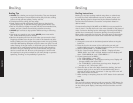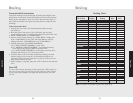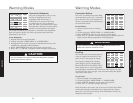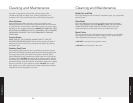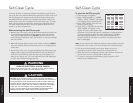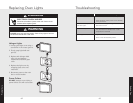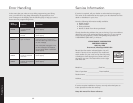
53
Broiling Instructions
Broiling is a dry-heat cooking method using direct or radiant heat.
It is used for small, individualized cuts such as steaks, chops, and
patties. Broiling speed is determined by the distance between the
food and the broil element. Choose the rack position based on
desired results.
Conventional broiling (LOW, MED or HI BROIL) is most successful for
cuts of meat 1-2 inches thick and is also more suitable for flat pieces of
meat. Convection broiling has the advantage of broiling food slightly
quicker than conventional. Convection broiling of meats produces
better results, especially for thick cuts. The meat sears on the outside
and retains more juices and natural flavor inside with less shrinkage.
To Use Broil:
1. Arrange the oven rack in the desired position before turning the
broiler on.
2. Place the food in the center of the cold broiler pan and grid
supplied with your oven, and then place the broiler pan in the oven.
3. Select “UPPER OVEN” or “LOWER OVEN.”
4. Set the Oven Function Selector to “BROIL.” Display will show
“BROIL HIGH” and “ON” will flash. Medium and low displays will
show “CONV BROIL M” and “CONV BROIL L.”
5. Choose power level for BROIL:
a. For “HIGH BROIL,” press “SET.”
b.For “MEDIUM BROIL,” press down arrow key once. Display will
change to MED, then press “SET.”
c. For “LOW BROIL,” press down arrow key twice. Display will
change to “LO,” then press “SET.”
6. Close the door to the oven. With closed-door broiling, the broil
element might cycle on and off if an extended broiling time is
required. A built-in smoke "eliminator" in the top of the oven will
help reduce smoke and odors.
7. When cooking is complete, press the “OFF” button for the selected
oven.
Oven Off
The oven will continue operating until you press the “OFF” button for
the oven you are using. To turn the oven off, press the “OFF” button
on the control panel display. One beep will sound and the oven will
turn off.
Broiling
Operation
52
Operation
Broiling Tips
• ALWAYS use a broiler pan and grid for broiling. They are designed
to provide drainage of excess liquid and fat away from the cooking
surface to help prevent splatter, smoke, and fire.
• To keep meat from curling, slit fatty edge.
• Brush chicken and fish with butter several times as they broil to
prevent drying out. To prevent sticking, lightly grease broiler tray.
• Broil on first side for slightly more than half the recommended time,
season, and turn. Season second side just before removing.
• ALWAYS pull rack out to stop position before turning or removing
food.
• Use tongs or a spatula to turn meats. NEVER pierce meat with a
fork, as this allows the juices to escape.
• Remove the broiler pan from the oven when you remove the food.
Drippings will bake onto the pan if it is left in the heated oven after
broiling. While pan is hot, place damp paper towel over grid. Drizzle
with liquid dishwashing detergent and pour water over grid. This will
make cleaning of the pan easier, or the broiler pan can be lined with
aluminum foil to make cleaning easier. Be sure the foil extends up
the side of the pan. Although it is not recommended, the grid can
also be covered with foil. Be sure to slit openings to conform with
the openings in the grid so melted fat can drain through to prevent
spattering, smoking, or the possibility of grease fire.
Broiling



